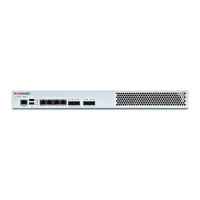Configuring Network Interface (Network Setting) How to set up your FortiWAN
Area Setting : Network is logically divided into a number of areas based on subnets. Admin-
istrators can configure area ID, which accepts numbers or IPs only.
Authentication Setting : Routers in different areas require authentication to communicate with each
other. Authentication types: Null, Simple Text Password, MD5.
Router Priority :
Set router priority. Router that sends the highest OSPF priority becomes DR
(Designated Router). The value of the OSPF Router Priority can be a number
between 0 and 255.
Hello Interval :
Set the interval, in seconds, to instruct the router to send out OSPF
keepalive packets to inform the other routers.
Dead Interval :
Set the length of time, in seconds, that OSPF neighbors will wait without
receiving an OSPF keepalive packet from a neighbor before declaring the
neighbor router is down.
Retransmit Interval :
Set the interval, in seconds, between retransmissions of Link ups. When
routers fail to transmit hello packets, it will retransmit packets in the defined
interval.
Authentication Type :
This specifies whether the router will perform authentication of data passing
the LAN. Choices are: Null, Simple Text Password, MD5.
FortiWAN provides statistics for the RIP & OSPF service, see "RIP & OSPF Status".
VRRP
VRRP is a Virtual Router Redundancy Protocol that runs on a LAN port. A system can switch between VRRP or HA
mode; when switched, the system will reboot first for changes to take effect. When VRRP mode is enabled, the HA
mode will be automatically disabled, and also a VRID field will appear available for input in [VLAN and Port Mapping]
setting page (See "VLAN and Port Mapping"). In general, VRRP is faster in detecting the master unit compared to HA
mode. Although FortiWAN's VRRP implementation is based on VRRP version 3, some restrictions may apply:
l Always in non-preempt mode.
l Always in non-accept mode.
l IPv6 is not supported.
l Active-active mode is not supported.
When FortiWAN switches to master mode, it automatically starts WAN link health detection. When it switches to
backup mode, it automatically stops WAN link health detection and sets WAN status to "failed".
In addition, DHCP servers in LAN and DMZ should let clients use FortiWAN virtual IP and the default gateway (as
FortiWAN's DHCP service does). If RIP and OSPF is used in LAN, FortiWAN uses real IP at OSPF and virtual IP at RIP
to exchange route information. Clone-MAC settings will be ignored if VRRP function is enabled. FortiWAN doesn't
exchange NAT table with VRRP peers. When VRRP master changes, existing connection might break.
Local Priority :
The priority field specifies the sending VRRP router's priority for the virtual
router. Select a number from 1 to 254 as the priority for the VR.
Advertisement Interval : Set the time interval in centi-seconds between advertisements. (Default is
100)
FortiWAN Handbook
Fortinet Technologies Inc.
52

